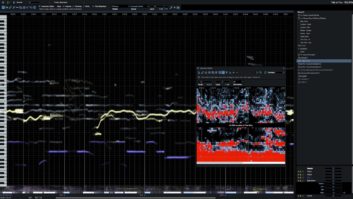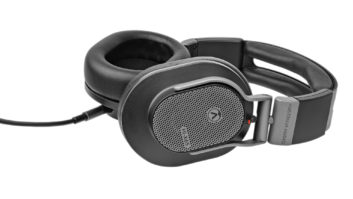
| MIX VERDICT: Lauten Audio LA-120 V2 Microphone |
| THE TAKEAWAY: “The overall package is not only a good value but also quite versatile, offering a wide range of tonal options.” |
| COMPANY: Lauten Audio • www.lautenaudio.com PRICE: $499/pair, including cardioid and omni capsules; inline pad: $79/pair. PROS: • Very good sound • Great bang for the buck • Versatile system CONS: • Output can overload some mic preamps even with the pad inserted • Pads are not included • Labeling is difficult to read |
Several months ago, Lauten Audio announced updated versions of its successful Series Black line of microphones, which includes the LA-320 (tube condenser), LA-220 (FET condenser) and the subject of this review, the LA-120 condenser microphone. V2s incorporate a number of refinements over the originals, including a polished and engraved nickel head grille, engraved hand-filled lettering, inset badge and an aesthetic update—all while maintaining the sonic attributes.
The LA-120 is a small-diaphragm (17mm), transformerless condenser microphone with a removable capsule, and the stereo set comes with a pair of cardioid and omnidirectional versions. Preamp circuitry employs through-hole construction and is spec’d for a dynamic range of 120 dB (minimum) with a sensitivity of 10 mV/Pa, -40 dB (0 dB = 1V/Pa @ 1 kHz).
Controls on the mic body include three-position highpass (flat, 50 Hz, 150 Hz) and lowpass (flat, 15 kHz and 10 kHz) filters, each with slopes of 6 dB/octave. The -10 dB pad is an inline, screw-on type that fits in between the body and capsule.
LA-120 V2s are packaged in pairs in a nice presentation box that houses the two microphones, two cardioid and two omnidirectional capsules, a pair of mic stand clips and a pair of mic stand mounts. Pads are available as an option.
Operation of the LA-120s is straightforward, though I feel like there should be a warning somewhere that phantom power should be turned off before changing the capsules or mounting/ removing the pads, as this is always a good practice. Phantom power requirements are spec’d at 48 VDC, but I was able to use the mics with an outboard phantom supply that provides 24 VDC.
HOT MIC, MINIMAL GAIN
 I tested the LA-120s in a variety of situations, and the first thing that became apparent is that the output level of these mics is hot, a characteristic indicative of Lauten’s philosophy of providing gear that can perform at a high level (pardon the pun) even when a user doesn’t have access to a lot of expensive outboard gear. Have no fear when connecting to a desktop recording interface that doesn’t provide a lot of gain—the LA-120s require minimal gain, even when used with a quiet source.
I tested the LA-120s in a variety of situations, and the first thing that became apparent is that the output level of these mics is hot, a characteristic indicative of Lauten’s philosophy of providing gear that can perform at a high level (pardon the pun) even when a user doesn’t have access to a lot of expensive outboard gear. Have no fear when connecting to a desktop recording interface that doesn’t provide a lot of gain—the LA-120s require minimal gain, even when used with a quiet source.
In line with that concept, I recorded a Taylor acoustic guitar using a Focusrite Scarlett 2i2 interface and was rather surprised to find that the instrument didn’t sound all that different than it did when I recorded it using some rather pricey outboard gear.
Using the cardioid capsules (no pads), reproduction of the instrument was clear, present and articulate, and background noise was barely audible—and then only when the studio monitors were cranked to unreasonable listening levels. Using the highpass filter in the 50 Hz position cleaned up a bit of room rumble, as well as some foot-tapping that would otherwise have been transmitted through the mic stand.
Sticking with the Scarlett and using the LA- 120s in cardioid for stereo drum overheads, it became evident that these microphones are capable of punching above their weight. Overall, the kit was well-balanced—though a close mic on the kick would have been helpful for adding a bit of weight and attack (not possible with the Scarlett, as it’s a two-channel interface). Cymbals, hi-hat and snare were crisp and clear, and the resonance of the toms came through very well. The LA-120s also captured a realistic representation of the room sound.
It’s worth noting that regardless of what preamp I used, the pads were required when using the LA-120s as overheads. Combining the LA-120s (cardioid) with a pair of Vintech X73i preamps for overheads on a different drum tracking session again yielded a great recording, where the imaging was spot-on and you could feel the nylon tip of a drumstick on the hi-hat.
It was during these sessions that I started experimenting with the lowpass filter, which produced some very interesting results. On overheads, switching the LPF to the 15 kHz setting was akin to making the hi-hat and ride cymbal take a step back in the mix, while reducing some of the sizzle from the ride and crash cymbals. Moving the switch to the 10 kHz position took that characteristic another step, mellowing out the crash cymbals and providing a nod in the direction of a ribbon transducer without sounding too dark.
The LPF was perfect for sweetening up a tizzy hi-hat or tambourine when the LA-120 was used up-close on those instruments. The LPF was very subtle when used on acoustic guitar, where the 15 kHz setting removed a bit of the metallic ringy-ness from the strings, and the 10 kHz setting darkened the sound ever so slightly.
These are subtle changes, not jaw-dropping differences, which makes them all the more useful. Changing the settings on either filter does produce an audible “tick,” so I’d suggest muting your speakers when doing so.
CLOSE-UP ON DRUMS, PIANO
Spurred on by a suggestion from the folks at Lauten Audio, I decided to try the LA-120s close-up on some drums. First up was a snare, with the pad and cardioid capsule. Initially, I thought that the mic couldn’t handle the SPL, but that proved not to be the case. It turned out that the output of the LA-120 was so hot when used close on snare that most of my preamps—including a Vintech X81, Drawmer 1969, Focusrite ISA110 and Avalon AD2022 (the latter with its pad switch on)—couldn’t handle the output without being overloaded. Using an external phantom power supply to run the LA-120, the mic could drive the X81 or ISA110 line inputs with plenty of level—in which case the mic produced a meaty, impactful snare sound.
Audix A127 Microphone — A Mix Real-World Review
When I placed the LA-120s (with pads) close-up on toms, I experienced similar results, with most preamps incapable of handling the level. One of the few preamps that did work in this application was the AEA TRP. I set the LPF off and the HPF to 50 Hz to tighten the bottom end a touch, which produced a round, full tone from the toms (note that I again used the outboard phantom power supply because the TRP does not provide phantom power).
Using the LA-120s to record an upright piano proved to be enlightening in several ways. As a reference, I A/B’d the LA-120s with a pair of cardioid condenser mics from another manufacturer that cost more than three times the Lautens. The microphone pairs sounded surprisingly close, though one could argue that the LA-120s had a bump in the low-mids, while the other pair proved a little smoother and tighter in that region. The top end, however, was very similar.
OMNI VS. CARDIOID
 In the piano session, I also tried the LA-120s with the omni capsules, which I preferred to the cardioid. Given that the mics were about six inches from the hammers, there was a noticeable proximity effect with the cardioid capsules. Switching to the omni capsules cleaned this up and improved clarity in the low-mids, and turning on the LPF mellowed out the attack of the hammers on the strings.
In the piano session, I also tried the LA-120s with the omni capsules, which I preferred to the cardioid. Given that the mics were about six inches from the hammers, there was a noticeable proximity effect with the cardioid capsules. Switching to the omni capsules cleaned this up and improved clarity in the low-mids, and turning on the LPF mellowed out the attack of the hammers on the strings.
On acoustic guitar, swapping the cardioid capsule for the omni made the guitar sound quite different, with much stronger midrange compared to cardioid. Combining the omni capsule with the 10 kHz filter provided a timbre closer to what you’d expect from a ribbon microphone.
In general, the cardioid capsules yielded higher output levels, sounded more “hi-fi” than the omni capsules, and, of course, reduced room sound in the recordings. The omni capsules produced a much flatter and less flattering character, often sounding more midrange-y than the cardioid capsules. Omni capsules on drum overheads softened the top end, giving the recording a retro vibe.
Lauten Audio has done an excellent job on the LA-120 V2, largely by resisting the temptation to “improve” the sonic characteristics of a microphone that has already won a lot of fans. The overall package is not only a good value but also quite versatile, offering a wide range of tonal options due to the filter settings and the different capsules (the quick-start guide even provides filter settings for various applications). My one caveat to a potential buyer would be that the pads are mandatory if your intention is to use the LA-120 close-up on loud sources.
Still, if you’re looking for a pair of small-diaphragm condensers in this price range, you owe it to yourself to check out the LA-120s.







